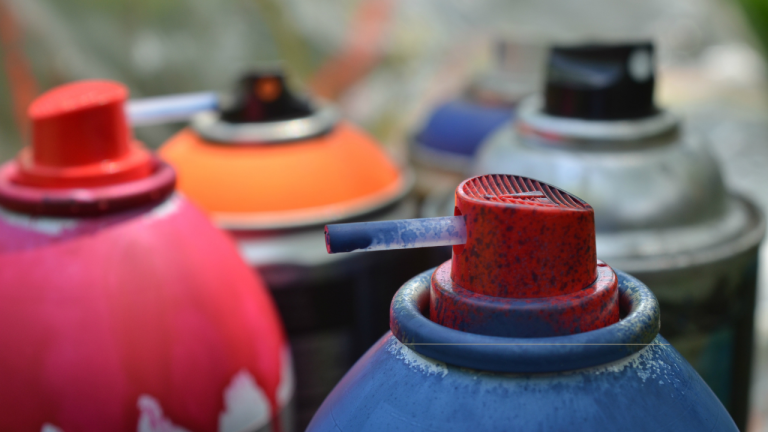Do you have a piece of metal that needs a fresh coat of paint? Maybe you’re looking to give your old bike a new look or want to spray paint some unique decorations for your garden. Whatever the project, proper preparation is key to getting a perfect finish. This blog post will show you how to prepare metal for spray painting so that your finished product looks great!
What you’ll need
Before starting spray painting, you will need to gather a few materials. First, you will need some paint stripper. It will help remove any paint or rust from the metal surface. Next, you will need to sand the metal surface with fine-grit sandpaper. It will create a smooth surface for the new paint to adhere to. Finally, you will need to apply a primer to the metal surface. It will help the color stick to the metal and prevent it from peeling or flaking off. With these materials, you will be able to prepare any metal surface for spray painting.
Methods on How to clean the metal surface
Metal surfaces, such as appliances or outdoor furniture, can become dirty and stained. While some people may opt for harsh chemicals to clean their metal surfaces, several more natural methods can be just as effective. For instance, one way to clean a metal surface is to mix baking soda and vinegar to create a past. This paste can then be applied to the metal surface and allowed to sit for several minutes before being scrubbed. Another option is to use a mixture of lemon juice and salt. This mixture can also be applied to the metal surface and allowed to sit for several minutes before being wiped away. These natural methods are not only effective at cleaning metal surfaces, but they are also safer for the environment.
How to Clean the metal surface using Baking Soda
You can use Baking Soda for many different things, including cleaning. When it comes to cleaning metal surfaces, baking soda is an excellent option because it’s abrasive enough to remove dirt and grime but gentle enough that it won’t damage the surface. To clean a metal surface with baking soda, make a paste of baking soda and water and apply it to the surface with a scrub brush or cloth. Once the paste has been applied, let it sit for a few minutes before wiping it away with a clean clot. For tougher stains, you may need to repeat the process. But once you’re done, you’ll have a clean, shiny surface that looks like new!

- CITRISTRIP Safer Paint & Varnish Stripping Gel is easy to use.
- Stays wet and active for up to 24 hours allowing stripping of multiple layers in one step.
- Removes dried latex and oil-based paint, varnish, lacquer, polyurethane and shellac.
- Strips multiple layers from wood, metal and masonry surfaces.

- Removes 15+ Layers of Paint/Coatings - Works on Wood, Brick, Metal, Concrete, Stone, Plaster, Fiberglass, Masonry, Porcelain, Bathtubs, Moldings, Tile, Glass, Decking, and Cinder Blocks.
- Safe Water-Based Formula – 100% biodegradable. No Harmful Smells. Fume Free. No dangerous chemicals or caustics, such as Methylene Chloride or NMP. Trusted by Painting Professionals.

- EVAPO-RUST PAINT REMOVER: SAFE-ERASE uses new, and powerful solvents to dissolve multiple layers of paint without the hazards of older technology.
- INGREDIENTS: Our Safe-Erase Paint and Varnish Remover is made from a premium non-flammable, non-carcinogenic and non-acidic solution. Does not contain caustic alkalis, methylene chloride, and N-Methyl Pyrrolidone.

How to Clean the metal surface using Vinegar
Metal surfaces can be challenging to clean, but Vinegar can be handy. Diluted Vinegar will do the trick- no need for any harsh chemicals. Apply the Vinegar to the surface with a cloth, and then scrub in a circular motion. You may need to put some elbow grease into it, but the dirt and grime should come right off. You can mix vinegar with baking soda to make a paste for tougher stains. Apply the paste to the color and sit for about 15 minutes before scrubbing it off. Whether you use straight Vinegar or Vinegar and baking soda, rinse the surface well when you’re finished. Otherwise, the acidic Vinegar might damage the metal.
How to Clean the metal surface using Lemon and Salt
Lemons are great for more than just making lemonade. You can also use lemonade for cleaning. The acid in lemon juice can cut through grime and dirt, making it an effective cleaning agent. Salt is another common household item that can use for cleaning. The abrasive nature of salt helps to scrub away stubborn dirt and grime. To clean a metal surface using lemon and salt, mix equal lemon juice and salt parts. Apply the mixture to the surface using a soft cloth or brush, and then rinse away with clean water. You may need to let the mixture sit on the surface for a few minutes before rinsing for more demanding jobs. Lemons and salt are inexpensive and effective cleaners, making them great.
How to Clean the metal surface using Chemical rust remover
Metal surfaces are susceptible to rust, especially when exposed to moisture or humidity. Rust can cause the metal to break down and deteriorate, so it’s essential to remove it as soon as possible. One way to do this is with a chemical rust remover. These products are designed to break down the rust and restore the metal surface to its original condition. To use a chemical rust remover, apply it to the affected area and scrub with a brush until the rust comes off. You may need to repeat the process several times to remove all the rust altogether. Once the rust is gone, rinse off the metal surface with water and dry it thoroughly to prevent further damage.
How to sand the metal surface
The initial step is to clean the metal surface thoroughly. The objective here is to remove all the rust, oils, and debris that could interfere with the sanding process. You can do this using a wire brush attachment on a drill or a chemical cleaning solution. Once the surface is clean, you can begin sanding. Start with coarse-grit sandpaper and work your way up to a finer grit. Use an orbital sander in a steady, back-and-forth motion for optimal results. Be sure to keep the sander moving to avoid damaging the metal surface. After sanding, you may want to apply a primer or paint to protect the metal from corrosion.
How to prime the metal surface
Painting metal surfaces can be tricky- if you don’t prepare the surface properly, the paint is likely to chip or peel. One way to ensure a good bond between paint and metal is to prime the surface first. Primer provides a smooth base for paint to adhere to, and it also helps prevent rusting. When choosing a primer, select one specifically designed for metal surfaces. Apply the primer with a brush or roller, and let it dry completely before proceeding with painting. With a little bit of preparation, you can achieve a professional-looking finish for years to come.
What is the Best Paint to Use in Metal?
When it comes to painting metal, there are a lot of different products on the market. However, not all spray paints are created equal. For best results, look for a paint that is specifically designed for use on metal surfaces. These paints usually have a high level of adhesion, which helps to prevent chipping and peeling. In addition, they are often resistant to rust and corrosion. When choosing a paint color, consider that darker colors will usually provide better coverage. If you’re looking for a specific finish, you can also find spray paints that produce a matte, glossy, or even hammered effect. With so many options available, it’s easy to find the perfect paint for any project.

- Works on virtually any surface including wood, plastic, metal, fiberglass, concrete, wicker, vinyl and more
- Oil-based formula with excellent adhesion prevents rust, resists fading and chipping for a long lasting finish
- Fast drying formula dries to the touch in 30 minutes and covers up to 15 sq ft per can
- Prevents rust and corrosion for enhanced durability
- Matte finish provides an attractive, soft sheen on surfaces

- Ideal for creating a shiny metallic finish on any interior metal, wood, concrete or masonry projects
- Paint features excellent chip resistance and color retention will keep your projects looking good over time
- Dries to the touch or handle in 60 minutes for quick project completion
- Tough, attractive finish will not fade or dull when used indoors
- Classic, elegant finish is great for painting accent pieces

- Weather and corrosion resistant coating protects exterior/interior surfaces like wood, metal, concrete, masonry and more
- Oil-based formula provides a durable protective coating with excellent rust prevention
- Dries to touch in 2 to 4 hours and covers up to 15 sq ft
- Excellent resistance to abrasion, fading and chipping
- Hammered metal finish minimizes surface imperfections

How to Spray Paint the metal surface
If you’re looking to add a little color to a metal surface, spray painting is a great option. It’s relatively inexpensive, and it can give any object a new lease on life. Plus, it’s not as difficult as you might think. Follow these simple steps, and you’ll be on your way to a beautiful finish.
The first step is to clean the surface you’ll be painting. It is crucial for getting a smooth, even finish. Be sure to remove any rust, dirt, or grease before starting. Once the surface is clean, apply a coat of primer. It will help the paint stick better and provide a base for the color. Next, choose your paint color and apply it to the surface. Start with light, even coats, and build up to the desired coverage. Finally, allow the paint to dry completely before using or handling the object. With a little bit of time and effort, you can achieve excellent results.
How to keep spray paint from chipping off metal
When it comes to painting metal surfaces, one of the biggest challenges is preventing the paint from chipping and flaking off. You can do a few key things to ensure that your paint job lasts. First, make sure that the surface is clean and free of grease or dirt. Second, sand the surface lightly to create a rough surface for the paint to cling to. Third, apply a primer designed for use on metal surfaces. It will help make a smooth surface for the color to adhere to. Finally, use high-quality paint designed for use on metal surfaces. By following these simple steps, you can ensure that your paint job will last for years to come.
Conclusion
So, there you have it! Our top tips for prepping metal for a perfect spray paint job. By following these simple steps, you can ensure that your paint will adhere evenly and look great when it’s finished. Have fun with your project, and show us the results!





